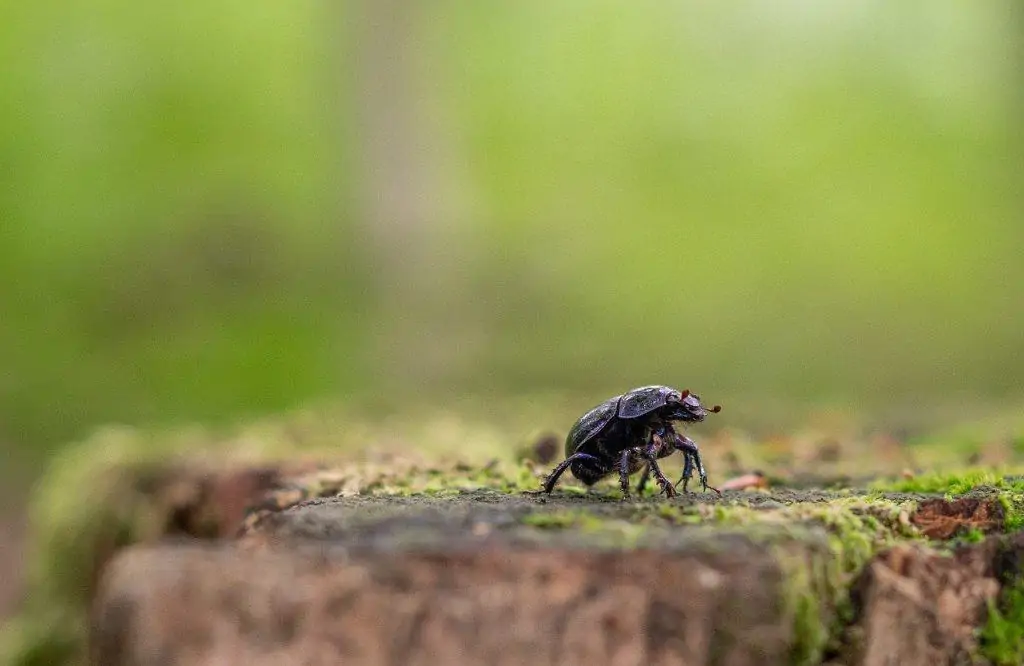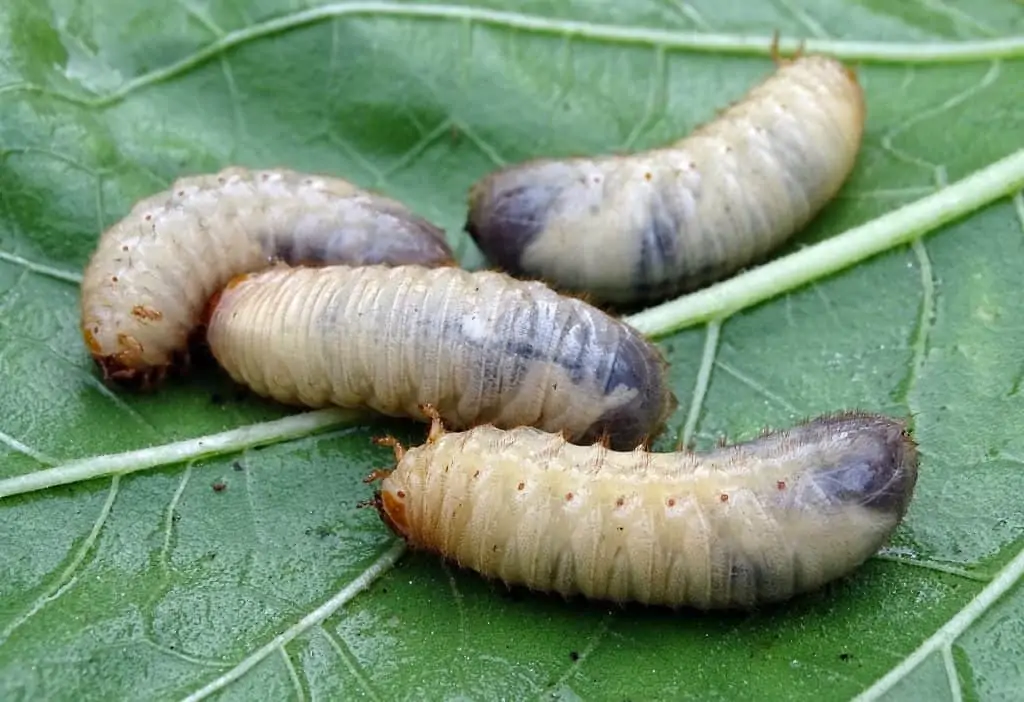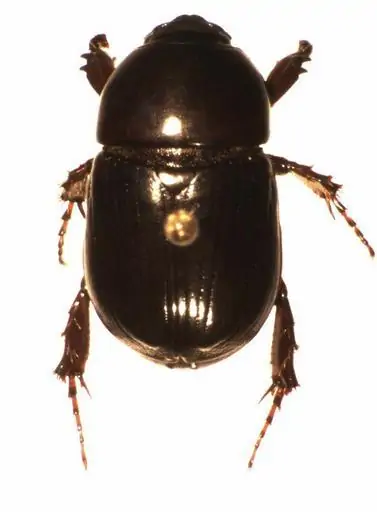Is your yard riddled with dead patches of grass, wilted tree leaves, and gloomy looking flowers? If you’ve noticed that your yard and garden is suffering no matter how much you water or care for it, you may be dealing with a pest infestation.
Determining which type of pest you’re dealing with is key to ensuring you are able to treat the problem at its source. So, if you suspect you are dealing with a Black Beetle infestation, you’ve come to the right place.
Contents
What Is The African Black Beetle?
Also known as the African Black Beetle or Black Lawn Beetle, the Black Beetle is an invasive species of Beetle native to Africa.
Origin: Africa
Scientific Name: Heteronychus Arator (Fabricius)
Other Names: The African Black Beetle, The Black Beetle, The Black Lawn Beetle
Overview Of The African Black Beetle:
The African Black Beetle is an invasive species of beetle native to Africa, as its name suggests. It was likely brought to the United States by way of human travel. These beetles are common throughout the United States, but are most common in the Northern United States and in the Eastern Rockies.
Generally, Black Beetles are most active during the warmer months of spring and summer. They have a short lifespan of less than a year, and typically spend most of their life either as larvae, pupating, or overwintering below the surface of the soil.
Still, these are incredibly damaging pests, especially to newly planted vegetation, seedlings, or weak and unhealthy gardens. Because they have such a vast diet, Black Beetles can be particularly damaging to agriculture.
They feast on a wide variety of plants, grasses, and edible vegetation, and are most damaging in their larvae and adult stage.
The African Black Beetle Life Stages
Black Beetles go through four life stages. As larvae, they also go through three instars.
The African Black Beetle goes through four life stages, and two of them are incredibly damaging to lawns and gardens. These stages are known as the larvae stage and the adult stage.
In other words, these are the two stages in which the African Black Beetle is mobile and eating. The other two stages include the egg and pupae stage, in which the African Black Beetle is dormant.
Let’s take a closer look at the four stages of an African Black Beetle below.
The Egg Stage
Female African Black Beetles lay their eggs in spring, just below the surface of lawns or gardens. They lay anywhere from six to 12 eggs at a time, though a single female is only able to lay around 30 throughout her life.
These eggs then take around two to five weeks to hatch. The eggs are relatively harmless during this stage, and you likely will not even know you have an issue until the larvae begin to hatch.
The Larvae Stage
After the larvae hatch from their eggs, they emerge to feed on the roots of vegetation below the surface. This is one of the most damaging stages of the African Black Beetle, as we mentioned above, as larvae can damage and kill vegetation from the root up.
African Black Beetle larvae go through three instars, or larval stages. During each instar, the larvae molts as it grows. In the beginning, African Black Beetle larvae are around 5 mm in length. By the time they fully mature, they have usually reached about 25 mm.
This process takes several weeks, and can last from spring throughout summer and into early fall, at which point the larvae pupate.
The Pupae Stage
The pupae stage of an African Black Beetle is another harmless stage in which the larvae are dormant. This stage occurs in late summer and early fall, and happens when the mature larvae burrow deeper into the soil to pupate.
This stage takes around two weeks, in which the Larvae shrink to around 15 mm and change in color. They are inactive during this stage, and do not feed until they reach adulthood.
The Adult Stage
Once the African Black Beetle has reached its adult stage, it will emerge from the earth. They may be slightly active as early adults if they emerge during the late summer and early fall, but they become much less active as soon winter arrives.
When the cold weather hits, adult African Black Beetles typically over winter below the surface of the soil. They remain there until spring, at which point they are fully mature. During this time, they will feed on a variety of plants, preferring grass shoots and roots below and just above the soil.
They can survive for up to 10 months, at which point they typically procreate and then die shortly after.
The African Black Beetle – Most Vulnerable Types of Vegetation
Even potted plants are not safe from a Black Beetle infestation.
As we mentioned above, the African Black Beetle has a very diverse diet and is able to feed on a variety of plants and vegetation. They also procreate rapidly and can easily infest yards and gardens if not monitored or controlled.
While Black Beetles can target a number of vegetation, there are some plants that are particularly vulnerable. These types of plants include newly planted vegetation, seedlings, young plants, and plants that are already damaged, overwatered, underwatered, or unhealthy.
Let’s take a closer look at the types of plants most commonly impacted by a Black Beetle infestation.
Vegetation Most Commonly Affected By Black Beetles
A wide variety of plant life and vegetation can be impacted by both African Black Beetle larvae and adults. In fact, most grassy turfs, lawns and gardens can suffer greatly, especially if they are young. Some of the most commonly impacted plants and vegetation are listed below.
Affected Grasses Include
- Kikuyu Grass
- Buffalo Grass
- Ryegrass
- Couch Grass
- Fescue Grass
Affected Ornamental Plants Include Succulents, Roses, Trees, Shrubs and Other Flowering Plants Such As:
- Protea
- Eucalyptus Seedlings
- Begonia
- Clover
- Calendula
- Petunia
Affected Edible Plants Include Potted Plants, Fruit Trees, Citrus, Herbs, and Garden Vegetables Such As:
- Carrots
- Grape Vine
- Cabbage
- Corn
- Olive
- Pineapple
- Lettuce
- Potatoe
- Tomato
- Strawberry
- Rhubarb
- Squash
- And Zucchini
How To Recognize African Black Beetle Damage
Patchy grass or dying vegetation is a common sign of beetle problems.
The African Black Beetle can procreate quickly, and while a female Black Beetle may only lay around 30 eggs in her lifetime, it is very simple for a Black Beetle infestation to get out of control if you’re not vigilant.
Not only does it help to understand the life stages of the African Black Beetle and when they are most active, but it also helps to recognize the early signs of Black Beetle damage so you know to take action.
Signs Of Black Beetle Damage To Grass and Turf
Grass and turf are especially vulnerable to Black Beetle larvae, as female Black Beetles tend to lay their eggs here just below the surface of the soil. Grass provides an abundance of food for Black Beetle Larvae, as well as a safe place to burrow and puppet.
Some common signs of Black Beetle damage to turf and grass include:
- Brown Patches In Grass
- Dead or Dying Patches of Lawn
- Wilted Grass
- Straw-Like Grass
- Severed Shoots
- Grass or Turn With A Frayed Appearance
- Turf That Easily Comes Away From The Earth When Lifted
Signs of Black Beetle Damage To Plants and Vegetation
One of the reasons Black Beetles are so damaging is because they have such a wide variety of plants and vegetation they can feast on.
As we mentioned previously, the African Black Beetle can also target other plants and vegetation. Unfortunately, they have a specific affinity for certain vegetable gardens and citrus trees, as well as ornamental plants.
Some common signs of Black Beetle damage to ornamental plants and vegetation include:
- Wilted Foliage, Leaves, or Stems
- Plants Experiencing Stunted Growth
- Deformed Plants or Flowers
- Unhealthy Gardens
- Uprooted Plants or Plants With Severed or Shredded Roots
- Gridling or Ringbarking Around Stems of Plants
- An Unhealthy or Chewed Rootsystem (Upon Uprooting Plants)
- Holes Or Deformities in Potatoes, Squash, Zucchini, Etc
- Dead or Dying Plants and Vegetation
Other Common Signs of African Black Beetles
This video gives a brief description on signs of Black Beetles and their larvae, as well as a few ways to treat the issue.
Other signs of African Black Beetles in or around your yard including the physical signs of these insects. If you suspect you have Black Beetle larvae or pupae below the surface of your lawn or garden, you can dig out a small patch of soil to check.
You can also draw these pests out of your lawn by combining a bucket with liquid dishwashing detergent. Choose a patch of lawn you predict is affected, and soak the area with water. Next, apply a damp towel to the area and leave it overnight.
In the morning, lift the towel and look for signs of larvae that have emerged from the grass.
Black Beetle larvae are wingless and are between 5 and 25 mm in length depending on their maturity. They are cream in color, have a brown or orange head, and three pairs of segmented legs on their underside.
They are also often C-shaped.
Adult African Black Beetles grow to be between 12 to 15 mm in length. They have oval shaped bodies and, in spite of their name, are typically more dark brown than black. They have a small head complete with two mandibles, short antenna, and three pairs of legs on each side of their thorax.
All adults have wings, though these wings lay flat on their thorax. They are slow moving when they walk, though they can fly and are highly attracted to light. You may notice an abundance of adult African Black Beetles during the evening when sitting out on your porch. They may also beat against windows after dusk during spring and summer.
If you do notice any of the above signs of African Black Beetles, whether you physically see them or you notice the damage from their larvae, it’s time to set up a game plan for Black Beetle control.
Let’s learn more.
Best Products For Getting Rid Of Black Beetle Eggs, Larvae and Pupae
The larval stage is one of the most destructive when it comes to a Black Beetle infestation.
Although the Black Beetle is most damaging in its larvae and adult stages, it is important to take care of and control this pest during all of their life stages in order to reduce potential damage.
Targeting eggs and larvae is often one of the most effective ways you can control a Black Beetle problem around your yard and garden. While there are a few home remedies you can use to get rid of Black Beetle eggs and larvae, some of the most effective methods include products you can purchase.
Nature’s Good Guys – Beneficial Nematodes
No products found.
When it comes to getting rid of a Black Beetle problem at the source, most experts are going to recommend you invest in beneficial nematodes. Beneficial nematodes, like those listed above by Nature’s Good Guys, are microscopic organisms that feed on a variety of common garden pests like Black Beetle larvae, weevils, ants, moths, and more.
Scientifically known as Heterorhabditis Bacteriophora, these tiny organisms are completely organic and safe to use around children and pets. They also won’t harm other beneficial insects like ladybugs, butterflies and bees.
The above product is made with a triple blend of different types of nematodes to help control and prevent pests from maturing and damaging yards and gardens. Each package contains 50 million live nematodes and can cover up to 12,500 square feet.
BioAdvanced Grub Killer Plus
No products found.
Another grub killer we recommend for managing a Black Beetle infestation early is a product by BioAdvanced. This product is a grub killer that comes in the form of granules designed to be sprinkled around your lawn and garden. The product comes in a 20 pound bag and can cover up to 10,000 square feet.
Once applied, the granules are designed to sit overnight. The product is activated once it is watered and is designed not only to kill Black Beetle larvae, but also other larvae and pests including ants, chinch bugs, ticks, cutworms, earwigs and grasshoppers.
While it is effective, we should note that this product contains chemicals and active ingredients that could be harmful to people and pets, and potentially the environment if not used as directed. Be sure to read the instructions carefully and keep this product out of reach of children and pets.
Best Products For Getting Rid Of Black Beetle Adults
Adult Black Beetles can be just as damaging if not more damaging than larvae, as they feast on plants both above and below the surface.
Adult Black Beetles can be tricky because they live both above and below the soil. They are most active during spring, summer and early fall, so it’s during these months when you’ll be best able to control them.
There are a variety of ways you can manage a Black Beetle infestation while beetles are adults, but you should still also use these products and methods in conjunction with products to get rid of larvae and eggs as well.
Diatomaceous Earth
No products found.
Also known as DE, Diatomaceous Earth is a completely natural and organic compound made from fossilized algae. It works against any pest with a hard exoskeleton, which means it will be effective against adult Black Beetles.
The product works when pests walk through it, and the powder attaches itself to the pest’s body. The exoskeleton of hard-bodied insects is designed with a waxy exterior made to hold in moisture. Diatomaceous Earth penetrates this waxy protection, which causes the pest to dehydrate and die.
Diatomaceous Earth is quite effective, but it does have a number of pros and cons. When used correctly in gardens and yards, it is completely harmless to people and pets. It is also safe for the environment and will not harm beneficial insects and plants.
However, it does need to be reapplied often as it is less effective once it becomes wet. Furthermore, it only works if the pest has direct contact with it. For best use, we recommend using DE in conjunction with other methods of control to manage a Black Beetle infestation.
HARRIS Beetle Spray
No products found.
Another common way to manage Black Beetles and other yard and garden pests is to use a pesticide spray. HARRIS Beetle Spray above works for a variety of hard-bodied insects including Black Beetles, Lady Beetles, Box Elder Bugs and more.
After application, the spray dries and continues to kill pests like Black Beetles for several weeks.
This spray is effective, but it also contains some harsh chemical ingredients that can be harmful to people, pets and the environment. Again, read the directions and use this product only as directed.
Home Remedies To Get Rid Of A Black Beetle Problem
Lavender oil is a lovely smelling option for getting rid of a Black Beetle problem.
Home remedies can work and work effectively when used correctly against Black Beetles. Many of the below home remedies can also work in protecting your yard and garden from other pests as well, including mosquitoes and Japanese Beetles.
Best of all, many of these home remedies for Black Beetle control are made with ingredients you likely already have inside your home.
Neem Oil
Neem oil has a variety of household uses, but it is also very popular when used as a natural form of pest control. Made from the pressed seeds and fruits of plants and trees, Neem Oil can be completely organic. It is safe to use on a variety of plants and is a wonderful deterrent for Black Beetles.
It is widely used as a natural pesticide for other insects as well including aphids, whiteflies, mites, thrips and mealybugs.
Soapy Water
Combine a few drops of liquid dish soap into a spray bottle filled with water and you have yourself a homemade pest control for Black Beetles and other insects. This spray can be used to deter and kill Black Beetles on contact by simply spraying it directly on them when you come across them.
Soapy water can also kill larvae and eggs when used properly, though it is not as targeted or effective when generally used without being sure of where the pests are living.
Furthermore, it should also be noted that using soapy water directly on plants and lawns can damage vegetation. Before using soapy water to control a Black Beetle problem, it’s best to do your research on the ingredients in your liquid soap and which types of plants you plan to use this soap on to prevent damage.
Companion Planting
As we will discuss further down, companion planting is an excellent alternative to using pesticides and insecticides in your lawn and garden. If you’re looking for a natural way to repel and control Black Beetles and their larvae, you might consider planting a few plants in and around your garden and lawn that these pests are deterred by.
Some of the best plants you can use to deter Black Beetles include garlic, chives, catnip, rue, citronella, tansy, nasturtium, white geranium and marigold.
Essential Oils
Last, we have essential oils. There are several essential oils you can use for pest control, though not all of them will work well for a Black Beetle problem in particular.
Some of the most effective essential oils for controlling a Black Beetle infestation include:
- Lavender Oil
- Peppermint Oil
- Eucalyptus Oil
- Citrus Oil
- And Tea Tree Oil
You have a few options you can use when it comes to utilizing essential oils most effectively foro pest control and managing a Black Beetle infestation.
Essential Oil, Soap and Water
Combine two cups of water and 10 to 15 drops of the essential oil of your choice in a spray bottle. You may also add two or three drops of liquid dish soap as well. Shake the bottle until the mixture is sudsy and spray it wherever you have noticed Black Beetle activity.
Essential Oils and A Cotton Ball
Saturate several cotton balls in the oil of your choice and place them around your yard and garden, focusing on where you notice damage or Balck Beetle activity. The smell from the oil can deter the pests, but you must replace the soaked cotton balls once every three days.
Keeping The African Black Beetle At Bay – Tips On Control and Prevention
Before planting, be sure to do some investigating in the soil for evidence of Black Beetle eggs or grubs.
A Black Beetle infestation can become a vicious cycle, especially if you don’t catch it early. It can be difficult to control an infestation once it’s taken hold, which is why it’s much easier to use preventative measures first in order to reduce your chances of dealing with an infestation.
Of course, if you have already worked to get rid of a Black Beetle infestation, you’ll certainly want to follow the below steps for prevention as well.
There are a few ways you can go about preventing a Black Beetle infestation. Take a look.
Invite the Predators
African Black Beetles have a long list of natural enemies, and you can take advantage of this by inviting some of them to your property. Some of the most common natural predators of the Black Beetle include:
Monitor Your Yard Before You Plant
Keep an eye out for common signs of Black Beetle larvae and adult African Black Beetles, and be careful of when and where you plant. Before planting in the spring, inspect for Black Beetles by digging at least 20 centimeters into the soil in search of eggs, larvae, or adult beetles.
If you do find beetles, treat your yard or garden before planting to get rid of them. If you already have a garden or yard that is being targeted, it is best to continue using the treatment methods listed above to help get rid of the Black Beetles as efficiently as possible.
Keep Up With Proper Landscaping
Routine landscaping like watering, mowing, and fertilizing can help ensure your yard, plants and lawn are healthy. Healthier plants are able to better withstand pest attacks, which can reduce damage and help when it comes to treatment.
Continue To Have Your Lawn Dethatched Regularly
Dethatching your lawn on a regular basis disrupts the soil below the surface, making it inhabitable for eggs, larvae, pupae and Black Beetles. Keeping up with this will not only help keep Black Beetles at bay, but a variety of other ground-dwelling pests as well.
Keep Up With Routine Pest Control Methods Year Round
Other types of yard and garden pests can aid in weakening plants and trees, which can lead to a worsened and more destructive Black Beetle infestation down the road. To avoid this, it’s best to keep up with routine pest control methods for a variety of pests common in your region all year round.
Avoid Certain Outdoor Lights
Many pests are attracted to outdoor lighting, but there are some outdoor lights that are more attractive to pests than others. Bright white lights tend to attract Black Beetles most, so experts recommend using yellow lights instead.
Some yellow outdoor lights can even help repel certain pests like Black Beetles, Mosquitoes, Moths and more.
Plant Black Beetle Repellent Plants
Companion planting has long been considered a safe and effective alternative to using pest sprays and chemicals to protect gardens. While Black Beetles do have a vast diet, they are also sensitive to certain plants and tend to steer clear of them.
Some of the most common plants you can use in your yard and garden to repel Black Beetles include:
- Garlic
- Chives
- Citronella Grass
- Catnip
- Rue
- Tansy
- Marigold
- Nasturtium
- And White Germanium
And remember, once you’ve managed to put your preventative tactics into play, it’ll be up to you to keep your eyes open, be vigilant, and ensure those pesky black beetles don’t come back next season for another free meal at your expense.
So, what do you think about the Black Beetle and our Black Beetle control methods? Have you tried any of the above products on our list? Tell us what you think in the comment section below.


Jack founded our blog after two decades of working in the pest control industry. His vast experience dealing with a wide array of pests allows him to diagnose issues quickly and get to the heart of pest problems quickly and effectively. He has serviced more than 2,000 homes over his career and there is hardly any pest situation that he has not seen before.








